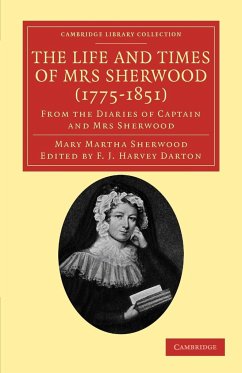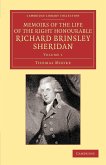- Broschiertes Buch
- Merkliste
- Auf die Merkliste
- Bewerten Bewerten
- Teilen
- Produkt teilen
- Produkterinnerung
- Produkterinnerung
A 1910 biography, based on diaries, of the successful children's author and passionate educationalist Mary Martha Sherwood (1775 1851).
Andere Kunden interessierten sich auch für
![Memoirs of the Life of the Right Honourable Richard Brinsley Sheridan Memoirs of the Life of the Right Honourable Richard Brinsley Sheridan]() Thomas MooreMemoirs of the Life of the Right Honourable Richard Brinsley Sheridan56,99 €
Thomas MooreMemoirs of the Life of the Right Honourable Richard Brinsley Sheridan56,99 €![The Life and Works of David Lindsay The Life and Works of David Lindsay]() Bernard SellinThe Life and Works of David Lindsay52,99 €
Bernard SellinThe Life and Works of David Lindsay52,99 €![National Life and Character in the Mirror of Early English Literature. by Edmund Dale National Life and Character in the Mirror of Early English Literature. by Edmund Dale]() Edmund DaleNational Life and Character in the Mirror of Early English Literature. by Edmund Dale41,99 €
Edmund DaleNational Life and Character in the Mirror of Early English Literature. by Edmund Dale41,99 €![The Life of Henry, Third Earl of Southampton, Shakespeare's Patron The Life of Henry, Third Earl of Southampton, Shakespeare's Patron]() Charlotte Carmichael StopesThe Life of Henry, Third Earl of Southampton, Shakespeare's Patron47,99 €
Charlotte Carmichael StopesThe Life of Henry, Third Earl of Southampton, Shakespeare's Patron47,99 €![Memoirs of the Life of the Right Honourable Richard Brinsley Sheridan Memoirs of the Life of the Right Honourable Richard Brinsley Sheridan]() Thomas MooreMemoirs of the Life of the Right Honourable Richard Brinsley Sheridan56,99 €
Thomas MooreMemoirs of the Life of the Right Honourable Richard Brinsley Sheridan56,99 €![The Clothing of Clio The Clothing of Clio]() Stephen BannThe Clothing of Clio38,99 €
Stephen BannThe Clothing of Clio38,99 €![Literature, Language, and the Rise of the Intellectual Disciplines in Britain, 1680 1820 Literature, Language, and the Rise of the Intellectual Disciplines in Britain, 1680 1820]() Robin ValenzaLiterature, Language, and the Rise of the Intellectual Disciplines in Britain, 1680 182035,99 €
Robin ValenzaLiterature, Language, and the Rise of the Intellectual Disciplines in Britain, 1680 182035,99 €-
-
-
A 1910 biography, based on diaries, of the successful children's author and passionate educationalist Mary Martha Sherwood (1775 1851).
Hinweis: Dieser Artikel kann nur an eine deutsche Lieferadresse ausgeliefert werden.
Hinweis: Dieser Artikel kann nur an eine deutsche Lieferadresse ausgeliefert werden.
Produktdetails
- Produktdetails
- Verlag: Cambridge University Press
- Seitenzahl: 562
- Erscheinungstermin: 17. Juni 2011
- Englisch
- Abmessung: 216mm x 140mm x 33mm
- Gewicht: 783g
- ISBN-13: 9781108033800
- ISBN-10: 1108033806
- Artikelnr.: 33777693
- Herstellerkennzeichnung
- Books on Demand GmbH
- In de Tarpen 42
- 22848 Norderstedt
- info@bod.de
- 040 53433511
- Verlag: Cambridge University Press
- Seitenzahl: 562
- Erscheinungstermin: 17. Juni 2011
- Englisch
- Abmessung: 216mm x 140mm x 33mm
- Gewicht: 783g
- ISBN-13: 9781108033800
- ISBN-10: 1108033806
- Artikelnr.: 33777693
- Herstellerkennzeichnung
- Books on Demand GmbH
- In de Tarpen 42
- 22848 Norderstedt
- info@bod.de
- 040 53433511
Mary Martha Sherwood was a nineteenth-century English children's writer. The best-known of her more than four hundred writings are The History of Little Henry and His Bearer (1814), as well as the two volumes The History of Henry Milner (1822-1837) and The History of the Fairchild Family (1818-1847). Her evangelicalism permeated her early writings, although her later works address popular Victorian subjects like domesticity. Mary Martha Butt married Captain Henry Sherwood and relocated to India for eleven years. She converted to evangelical Christianity, built schools for army commanders' children and indigenous Indian children, adopted abandoned or orphaned children, and established an orphanage. She was motivated to write literature for youngsters in military camps. Sherwood's career was divided into three periods: the romantic period (1795-1805), the evangelical period, during which she wrote her most popular and significant works, and the post-evangelical period. Her writing was characterized by "her conviction of inherent human corruption," her idea that literature "had a catechetical utility" for all levels of society, her opinion that "the dynamics of family life" should reflect basic Christian teachings, and her "virulent" anti-Catholicism. Sherwood's work has been described as "one of the most significant authors of children's literature of the nineteenth century". Her representations of domesticity and ties to India may have affected many young readers, but her work declined in popularity as children's literature expanded in the late nineteenth century.
Introduction
1. Ancestry and birth (1741-75)
2. Early days at Stanford (1775-87)
3. Kidderminster (1788-90)
4. Captain Sherwood's wanderings (1787-95)
5. School life (1791-3)
6. The last days of childhood (1794-6)
7. Retirement and marriage (1795-1803)
8. Following the camp (1803-5)
9. Round the Cape to India (1805)
10. From Calcutta to Dinapore by water (1805)
11. Illness and sorrow at Berhampore (1805-7)
12. Life and death at Cawnpore (1807-9)
13. A journey to Calcutta and back (1809-10)
14. Henry Martyn and Cawnpore (1810-12)
15. Meerut
16. The return to England (1816-17)
17. A fresh start (1817-21)
18. Pupils and family affairs (1822-51)
Appendix
Index.
1. Ancestry and birth (1741-75)
2. Early days at Stanford (1775-87)
3. Kidderminster (1788-90)
4. Captain Sherwood's wanderings (1787-95)
5. School life (1791-3)
6. The last days of childhood (1794-6)
7. Retirement and marriage (1795-1803)
8. Following the camp (1803-5)
9. Round the Cape to India (1805)
10. From Calcutta to Dinapore by water (1805)
11. Illness and sorrow at Berhampore (1805-7)
12. Life and death at Cawnpore (1807-9)
13. A journey to Calcutta and back (1809-10)
14. Henry Martyn and Cawnpore (1810-12)
15. Meerut
16. The return to England (1816-17)
17. A fresh start (1817-21)
18. Pupils and family affairs (1822-51)
Appendix
Index.
Introduction
1. Ancestry and birth (1741-75)
2. Early days at Stanford (1775-87)
3. Kidderminster (1788-90)
4. Captain Sherwood's wanderings (1787-95)
5. School life (1791-3)
6. The last days of childhood (1794-6)
7. Retirement and marriage (1795-1803)
8. Following the camp (1803-5)
9. Round the Cape to India (1805)
10. From Calcutta to Dinapore by water (1805)
11. Illness and sorrow at Berhampore (1805-7)
12. Life and death at Cawnpore (1807-9)
13. A journey to Calcutta and back (1809-10)
14. Henry Martyn and Cawnpore (1810-12)
15. Meerut
16. The return to England (1816-17)
17. A fresh start (1817-21)
18. Pupils and family affairs (1822-51)
Appendix
Index.
1. Ancestry and birth (1741-75)
2. Early days at Stanford (1775-87)
3. Kidderminster (1788-90)
4. Captain Sherwood's wanderings (1787-95)
5. School life (1791-3)
6. The last days of childhood (1794-6)
7. Retirement and marriage (1795-1803)
8. Following the camp (1803-5)
9. Round the Cape to India (1805)
10. From Calcutta to Dinapore by water (1805)
11. Illness and sorrow at Berhampore (1805-7)
12. Life and death at Cawnpore (1807-9)
13. A journey to Calcutta and back (1809-10)
14. Henry Martyn and Cawnpore (1810-12)
15. Meerut
16. The return to England (1816-17)
17. A fresh start (1817-21)
18. Pupils and family affairs (1822-51)
Appendix
Index.








